Warm water floors on a wooden floor: features of laying the system on a wooden base
Few people can be surprised by warm floors. The time has passed when it was considered an attribute of ultra-comfortable housing.Today it is installed everywhere to make your home even warmer and more comfortable. Owners of wooden buildings could not install such a system, since traditional installation technologies do not allow it.
With the advent of the flooring system, it is possible to lay warm water floors on a wooden floor without the slightest problem. We will tell you about all the popular options for installing an underfloor heating system based on lumber floors. Do-it-yourselfers will find a lot of useful tips here.
The content of the article:
Water floor: how does it work?
Water-type floors are a very practical way to heat a home. The system is a liquid heating circuit mounted under the floor covering.
Traditional technology assumes that the pipes lie in a concrete screed. A boiler is usually used to heat the coolant supplied to the circuit. Standard models heat the liquid up to 60-90ºС, which is unacceptable for heated floors.
If you put coolant at this temperature into the circuit, the floor will warm up to 45-60ºС. It will be impossible to walk on it. SNiPs regulate the permissible temperature for heated floors. This is no more than 30ºС.
To obtain this value, it will be enough to heat the liquid in the circuit to 35-45ºС. Therefore, the water floor system includes mixing unit. Here the hot liquid from the boiler heat exchanger and the cool liquid from the return pipe are mixed.
There is another simpler option. If you use a condensing type heating boiler, you will not need to install a mixing unit.
The design features of such boilers suggest the possibility of heating coolant to relatively low temperatures. In some cases, the heated coolant is taken from a centralized system, but this requires obtaining a special permit, which is not always possible.
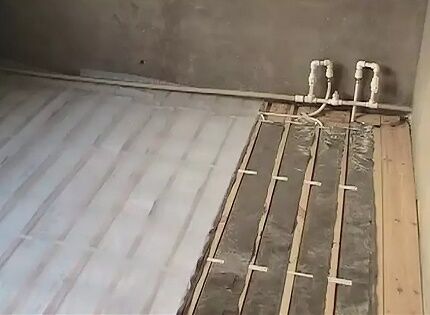
Thus, the liquid entering the heating circuit, and this can be an antifreeze solution or water, heats the floor. This, in turn, heats the air. The result is fast and at the same time very uniform heating of the room.
A significant plus is the temperature distribution in the room that is most favorable for humans. Cool air accumulates in the upper part, warmer air accumulates in the lower part. It is precisely this microclimate that living organisms regard as comfortable. At the same time, convective flows, inevitable in the presence of point heat sources, are not observed.
Thanks to this, there is no transfer of dust and microorganisms. The advantages include minimal operating costs. All this makes water floors popular among users. Comparative analysis of water and electric underfloor heating systems given in the article, which we recommend you read.
Features of the flooring system
The traditional version of a water-type floor involves installing pipes in a screed.It is poured with a concrete solution with special additives that increase its thermal conductivity.
As a result, the concrete pad becomes a kind of heat accumulator, which makes it possible to use such heating as efficiently as possible. However, the traditional arrangement method has disadvantages.
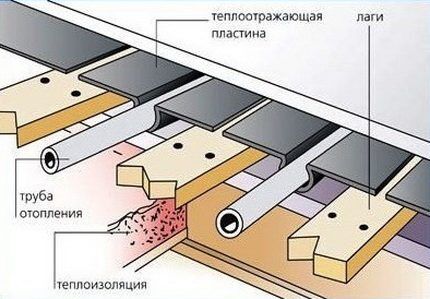
The most obvious is too much weight of the concrete screed. With a solution density of about 2000 kg/sq. m it gives a significant additional load on the base and load-bearing structures.
For reinforced concrete slabs, such a load is quite feasible. For wooden floors - prohibitive. For this reason, the traditional installation method is prohibited in such cases. The so-called flooring system is used here.
It is made in the form of a low flooring, inside of which pipes are located. Wood is most often used for its arrangement, but industrially produced polystyrene flooring has appeared relatively recently.
The pipes are placed in grooves where they are secured. It is known that wood conducts heat very poorly. For this reason, wooden systems cannot be an effective source of heat.
To correct this deficiency, metal heat-conducting elements are inserted into each groove. They also strengthen the structure. There are similar details in polystyrene flooring with metal inserts, the material of which is also a poor heat conductor. In this way, a reliable and durable heating system is assembled.
Its advantages over its traditional analogue can be considered:
- Light weight of the flooring, which even wooden floors can withstand.
- Relatively simple assembly, especially when it comes to industrial flooring models.
- There is no need to wait for the concrete screed to harden. Finishing work can be done immediately after installation.
- Full maintainability. To carry out repair work, it is enough to lift a fragment of the flooring to provide access to the area with the fault.
Another undeniable advantage of the flooring system is its versatility, which makes it possible to implement a variety of modifications. Most of which are homemade. The main disadvantage of the flooring scheme is rapid cooling. The floor heats up in a short time and gives off heat just as quickly.
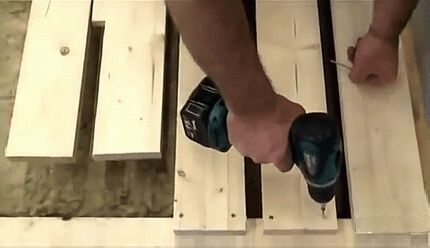
Actually, the heat supply is limited to that which is in the coolant liquid in the pipes. Therefore, when the boiler is stopped, the room will soon cool down. For this reason, flooring systems are often used as an addition to main heating, especially in cold regions.
Installation of a floor heating system
When laying a flooring system, you get a kind of multi-layer cake; let’s look at each layer in more detail.
Requirements for the foundation for the structure
The first layer of the cake is a properly prepared base. This can be any overlap that is pre-leveled. SNiPs regulate the absence of significant differences in heights, protrusions and roughness.The wooden floor must be level, without protruding boards.
Each board should be well secured and should not bend. The maximum permissible limit of deviation from the horizontal is 2 mm, distributed over 2 m of area in any of the existing directions.
Construction of the insulating layer
To prevent heat loss, it is necessary to install an insulating layer. The material for its implementation is selected individually, based on operating conditions. It must be moisture-resistant, fire-resistant and compatible with other building materials.
It is desirable that additional sound insulation be provided. If possible, the thinnest but most effective material is selected.
Pipe fixation option
The actual flooring under the pipes is laid on top of the insulation. There are many options here. These can be polystyrene mats with special bosses for pipes. Such mats are produced single and doubled with insulation.
In the latter case, the insulating layer may be superfluous. Sheets of lumber with cut grooves for pipes can be used as flooring. They are also produced industrially. There are also homemade floorings made from slats, bars, etc.
Pipe for moving coolant
Next, it is placed in the prepared fasteners and grooves. heat pipe. To ensure a tight fit and create a heat shield, the parts are placed inside a special aluminum profile.
If there is none, you can make similar elements from galvanized steel or wrap each part in thick foil. It is optimal to lay an additional layer of foil on top of the mounted pipes.
Construction of the foundation for finishing
A base must be laid on top of the pipes under the flooring. It is selected depending on what kind of finishing coating will be laid.
If you plan to install tiles, ceramic or PVC, as well as linoleum or carpet, moisture-resistant plasterboard is laid on the metal elements of the wooden flooring. If polystyrene mats were used to construct the flooring, GVL is laid in two layers.
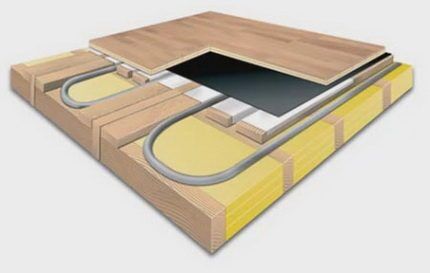
Drywall is not laid under laminate on wooden flooring. Instead, foamed polyethylene or a cardboard backing is placed on aluminum plates to absorb excess moisture.
Instead of GVL, you can use moisture-resistant types of chipboard or plywood. A good solution is glass-magnesium sheets, which also conduct heat well, which is absolutely not superfluous when arranging a heated floor.
Options for arranging a water floor
Flooring under a water floor can be made in a variety of ways, which is especially popular with home craftsmen. Let's consider several options for such designs.
Option #1. Implementation of a ready-made solution
This is the easiest method to implement. You can purchase a decking kit from a hardware store. There may be two types of such a solution. The first is polystyrene mats equipped with pipe fastenings.
They can be duplicated with a layer of insulation. In this case, they can be laid directly on the base.The main advantage of such mats is their extremely simple installation. However, they are not strong enough to install flooring directly onto mats.
Under soft coverings, as well as under tiles, you will have to lay two layers of gypsum board. The flooring can also be assembled from modules made from chipboard. They are factory-made with recesses for pipes with a certain system pitch. The modules are equipped with fasteners, metal heat-distributing plates and pipes.

To connect the parts together, a locking connection is provided, which greatly facilitates assembly. Such structures are quite durable and do not require additional reinforcement. Their main disadvantage is their high cost.
Any of the ready-made solutions requires careful preparation of the base. If it is an old floor, a thorough inspection is carried out. Damaged areas are discarded and repaired. The boards are securely fixed, height differences are eliminated. Then all debris and dust are removed and the base is primed.
After it has dried, insulation is laid and secured, if required. The next stage is laying the mats. A suitable adhesive, usually liquid nails, is applied to the outside of each of them, and the plate is glued to the base. It is important that the glue sets well and holds the mat securely in place.
If it is intended to lay chipboard flooring, it is assembled in strict accordance with the instructions issued by the manufacturer. After the pipe channels are ready, installation begins. Laying heated floor pipes can be produced by a “snake”, “snail” or any other suitable method.
The elements are combined into a single system and connected to the heating system. Next, pressure testing and testing of the functionality of the water floor is carried out, after which the installation of the floor covering begins.
Option #2. Flooring on joists
Work begins with preparing the wooden base. If it is an old floor, all necessary repairs are carried out. Then you need to lay the logs on which the warm water floor will lie under the wooden floor. The prepared logs are set strictly according to the level with a distance between elements of about 0.6 m.
This is the best option; you can place parts at a greater distance. But in this case, thicker boards will be required to form the flooring.
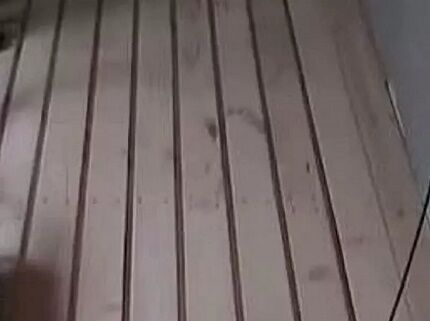
The beams are securely fixed to the base. Next, a base is built between them with lags, on which the insulation will be laid. To do this, boards, plywood, chipboard or any other suitable material are tacked to the beams.
If you want to save money, instead of a base, you can nail corners or slats to the joists, on which the insulating coating will rest. But you need to understand that in this case it should be hard and not friable. Insulation is laid on the prepared base. This can be polystyrene foam, high-density stone wool, polystyrene, etc.
After forming the heat-insulating carpet, they begin to manufacture the flooring. To do this, take boards with a thickness of at least 0.03 m.They begin to screw them to the beams. The first one is fixed at a distance of 0.02 m from the wall surface; a similar gap is made when fixing all other parts.
An important point is the choice of the width of the boards attached to the floor. It must correspond to the width of the metal heat distribution plates, which will subsequently be inserted into the resulting grooves.
The pipe will be laid in a “snake” pattern, which requires making grooves for its turns. To do this, leave special gaps about 0.15 m wide at equal distances from each other.

In practice, it looks like this: Two boards are screwed at a distance of 0.5 cm from the wall, the next two - at a distance of 5 - 7 cm. And so on until the end of the row.
On the opposite side of the base, those boards that were fixed to the wall are screwed at a distance, and those with a gap are screwed closely. This creates a groove for the bend of the pipe. After the entire flooring has been laid, the installation of heat distribution plates begins.
They are inserted into the grooves formed by the boards and securely secured with staples or regular nails. It is optimal for the sides of adjacent plates to meet.
Then a continuous heat transfer screen will be formed. Now you can start laying the pipes. It's easier to do it together. One worker will unwind the coil, and the second will do the actual laying.
With a little force, the part is pressed into the groove of the heat distribution plate. It is best to run the return pipe of the contour loop along the wall under the decking boards.
After the entire circuit has been laid, check again for correct installation and connect it to the heating system. The water floor must be pressure tested. Then you can begin preparing for laying the flooring.
Option #3. Guide design
They start by preparing the base. As in previous options, it must be leveled and strengthened. Then any suitable insulation is laid on the base.
The simplest method of laying a water floor is the “snake” method, which is why it is used most often. For a structure made of guides, this will be the best option. To determine the dimensions of the parts, an accurate floor plan is drawn.
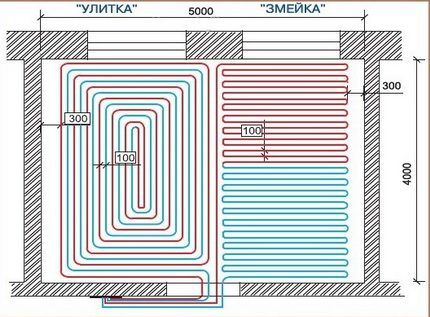
It marks the areas where the equipment serving the water floor will be installed and the places where the pipes will be connected. Then, with strict adherence to the selected laying step, guides are drawn. The number of required parts is calculated and their sizes are determined.
Now you need to prepare the guides. They are cut from any suitable and available material. After which you can begin installation. The parts must be laid on the base in strict accordance with the developed plan.
Each guide is placed on a rough base and securely attached to it with self-tapping screws. Between the parts there should be channels necessary for installing pipes. In areas where the pipeline turns, the sharp corners of the guides must be rounded so as not to accidentally damage the pipes.
After all the slats are secured to the base, begin laying the foil. To do this, take material with a thickness of at least 50 microns.The sheets are pressed into the channels, carefully going around each recess. Literally “laying out” foil on each channel.
To prevent the sheets from moving out of place, they are fixed to the slats using a stapler. For better heat transfer, it is advisable to wrap the pipes with the same foil before laying, but this is not necessary.
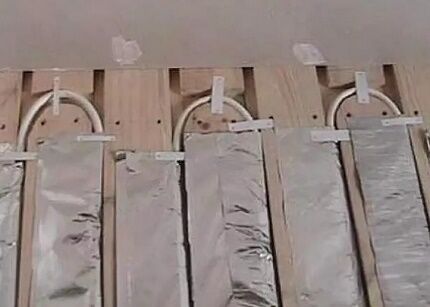
Then the pipe is laid inside the prepared channels. To hold it in place, in some areas it is attached to slats or to the floor with metal plates. Upon completion of installation, the water floor is connected to the heating system and mandatory pressure testing is carried out. If it does not reveal any leakage problems, begin preparing for the installation of the finishing coating.
These are only three options for installing floor heating. In practice there are many more of them. Home craftsmen adapt them to their conditions, selecting available materials and suitable technologies.
Will familiarize you with the rules, formulas and example of calculating an underfloor heating system next article, which we highly recommend reading.
Conclusions and useful video on the topic
Video #1. One of the flooring system options:
Video #2. Let's compare concrete and floor water floors:
Video #3. We lay the water floor on a wooden base:
A water floor can only be laid on a wooden base using the laying method. It will not withstand a concrete screed, even the lowest one. The simplest of all flooring options is to use ready-made polystyrene mats or wooden guides.
They can be purchased at any store.The only drawback of this solution is the high cost, but installation is simple and very quick. Those who like to do it themselves can easily assemble the flooring from scrap materials. It will turn out cheap and quite functional.
Please write comments in the block below. Tell us about how you built an underfloor heating system in your or a neighboring house with a wooden floor. Share useful information, ask questions, post photographs related to the topic of the article.




Everything is described in sufficient detail, but it will be very problematic to make and install such floors yourself even without practice. When you start doing it, everything is not as simple as it is written, many nuances arise. We installed it together with my godfather, and took a lot of information from here. We regretted that we had not consulted with some specialist in person; we would have spent less time and effort on installation.
Mikhail, but this is the essence of such publications, that you can learn in detail about the standard process if you want to do it yourself. It is clear that everything cannot be predicted, but if you call a specialist, you already need to pay him, then you will understand that you cannot do what the master advises, let him do it. So, the principle of maximalism works here: either yourself or a master.
Would you know how many people have to finish or redo these warm water floors. In general, people rarely adequately assess their ability to repair things.
After installing a heated floor system, is it necessary to lay, for example, plywood under the laminate?
Hello. No no need.You need to fill the screed.
I ask for advice - will such a warm floor be effective if it is installed under a rough wooden floor?